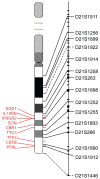Interaction between a chromosome 10 RET enhancer and chromosome 21 in the Down syndrome-Hirschsprung disease association
- PMID: 19306335
- PMCID: PMC2779545
- DOI: 10.1002/humu.20944
Interaction between a chromosome 10 RET enhancer and chromosome 21 in the Down syndrome-Hirschsprung disease association
Abstract
Individuals with Down syndrome (DS) display a 40-fold greater risk of Hirschsprung disease (HSCR) than the general population of newborns implicating chromosome 21 in HSCR etiology. Here we demonstrate that the RET enhancer polymorphism RET+9.7 (rs2435357:C>T) at chromosome 10q11.2 is associated with HSCR in DS individuals both by transmission disequilibrium (P=0.0015) and case-control (P=0.0115) analysis of matched cases. Interestingly, the RET+9.7 T allele frequency is significantly different between individuals with DS alone (0.26+/-0.04), HSCR alone (0.61+/-0.04), and those with HSCR and DS (0.41+/-0.04), demonstrating an association and interaction between RET and chromosome 21 gene dosage. This is the first report of a genetic interaction between a common functional variant (rs2435357) and a not infrequent copy number error (chromosome 21 dosage) in two human developmental disorders.
Copyright 2009 Wiley-Liss, Inc.
Figures


References
-
- Arron JR, Winslow MM, Polleri A, Chang CP, Wu H, Gao X, Neilson JR, Chen L, Heit JJ, Kim SK, Yamasaki N, Miyakawa T, Francke U, Graef IA, Crabtree GR. NFAT dysregulation by increased dosage of DSCR1 and DYRK1A on chromosome 21. Nature. 2006;441:595–600. - PubMed
-
- Chakravarti A, Slaugenhaupt SA. Methods for studying recombination on chromosomes that undergo nondisjunction. Genomics. 1987;1:35–42. - PubMed
-
- Chakravarti A, Lyonnet S. The Metabolic and Molecular Bases of Inherited Disease. 8. New York: McGraw-Hill; 2001. Hirschsprung Disease. Chapter 251.
-
- Delabar JM, Theophile D, Rahmani Z, Chettouh Z, Blouin JL, Prieur M, Noel B, Sinet PM. Molecular mapping of twenty-four features of Down syndrome on chromosome 21. Eur J Hum Genet. 1993;1:114–124. - PubMed
-
- de Pontual L, Pelet A, Clement-Ziza M, Trochet D, Antonarakis SE, Attie-Bitach T, Beales PL, Blouin JL, Dastot-Le Moal F, Dollfus H, Goossens M, Katsanis N, Touraine R, Feinjold J, Munnich A, Lyonnet S, Amiel J. Epistatic interactions with a common hypomorphic RET allele in syndromic Hirschsprung disease. Hum Mut. 2007;28:790–796. - PubMed
Publication types
MeSH terms
Substances
Grants and funding
LinkOut - more resources
Full Text Sources
Medical
Research Materials

